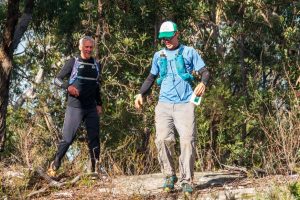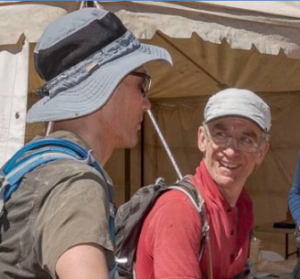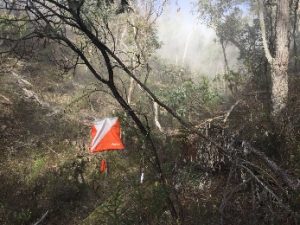Many seasoned rogainers will say that a long rogaine is a great life experience. I’d go further — a 24-hour rogaine is a microcosm of life itself. Over the years, I’ve completed many of these events, and each has taught me something about resilience, purpose, and what it means to keep going when things get tough. Here’s what I’ve come to appreciate most through the uniquely brutal joy of the “traditional” 24-hour event — especially as the 2025 NSW 24 hour Championships, “Werong A Mission”, fast approaches.
1. It’s a marathon, not a sprint.
Actually, compared to a 24-hour rogaine, a marathon is a sprint.
Sure, a road marathon might bring sharper pain to the legs — but the drawn-out physical and mental drain of a 24-hour rogaine, especially around the 4am mark, is something else entirely.
In my first attempt, my teammate and I charged off full of enthusiasm, only to crash hard after nightfall. I still remember him vomiting somewhere in the wilderness, and our sorry shuffle back to camp — followed by a sluggish few hours collecting a handful of low-value controls.
It took a few of those mistakes (and a lot of humble pie) to learn the value of a steady, deliberate pace. Going out hard can feel satisfying for a few hours — but staying strong for 24 takes strategy, patience, and mental toughness.
It’s one of the many paradoxes of the sport that some of the most consistent performers are decades into their rogaining careers — and still collecting mugs well into their Ultra Veteran years.
(That said, I do note that adventure races can last a week or more, so based on that logic a 24hr rogaine is a sprint… perhaps “sprint” is just a relative term…)
2. The crazier it is, the more memorable it becomes.
“There were three of us lost in the bush at 3am on a wet winter night…”
That’s either the start of a terrible joke or a brilliant memory.
As time goes by, I forget old work projects, movies I’ve seen, or what half my classmates even looked like. But I remember the 24hr rogaines — vividly. I remember the -5°C nights, the howling wind, the 20-point control we searched for over three hours, and the moments we walked right off the edge of the map.
At the time, I questioned all my life choices. But after a hot shower, a feed, some band-aids and sleep, those low points become the stories I tell most often. They’re what separate this weekend from all the others.
3. Mistakes are inevitable. Don’t let them define you.
There are two certainties in life: death and taxes. And in rogaining, mistakes.
Even the best navigators slip up, especially in the bleary-eyed hours of a 24-hour. What matters is how you respond.
Sure, I’ve made some shocking blunders (too many to admit), but the worst weren’t necessarily the biggest errors — they were the ones where I let the first mistake unravel everything else. The best recoveries came when I stayed calm, cut my losses, and got back on track.
Blaming your teammate, the organiser, or the map (cheers, government) may offer temporary relief — but never a solution. Staying level-headed is the only route to redemption — on the course or in life.
4. You often just have to push through pain.
Modern life seduces us into believing we can avoid discomfort — that painkillers, touchscreens and fast Wi-Fi can insulate us from hardship.
But no one escapes real life unscathed. Sooner or later, we face rejection, grief, failure or sudden change — and too many of us now struggle to cope when that time comes.
Rogaining doesn’t offer pain-free participation. Even with the best shoes and packs, a 24hr event hurts — physically and mentally. My acquaintances who’ve never done one are often shocked I keep going back. But through every blister, scrape, and sleep-deprived hallucination, I’ve learned to keep moving forward.
There’s power in knowing you’ve endured before — and can again.
5. There are highs and lows.
As Bill Watterson once illustrated in his iconic Calvin and Hobbes, life is a roller coaster — with peaks that exhilarate and valleys that test us. Few sports reflect that better than rogaining, where the literal highs and lows of elevation mirror the emotional ups and downs of the 24-hour journey.
- Constant climbs and descents drain your legs, but also provide crucial vantage points for navigation,
- One moment you’re wet, cold, lost, and exhausted — the next, you’re nailing a tricky 100-pointer or soaking in a breathtaking ridgeline view, and
- The low of walking in circles at 3am is often followed by the high of staggering into the Hash House at midday with nothing left — and maybe even hearing your team name called for a mug
Those oscillations — physical and emotional — are part of what makes the sport so memorable. After all, flat ground might be easy, but rarely leads to anything worth remembering.

A coveted NSWRA winner’s mug, which goes straight to the pool room.
6. It’s not an exact science.
An engineer once said: “My equations are an approximation to reality.” A physicist replied: “Reality is an approximation to my equations.”
Rogaining is more engineering than physics. You simplify complex terrain, estimate distance versus points, factor in contours, vegetation and navigation difficulty — and then the course reminds you who’s boss.
Life’s a bit like that too. You break problems into manageable chunks. The models are flawed, but they’re the only way to move forward.
(It’s therefore no surprise that rogaining attracts a healthy population of nerds — engineers, scientists, maths teachers, data junkies — all trying to bring logic to the chaos.)
7. Plan well — but not too rigidly.
Good planning is essential, but so is adaptability — both in rogaining and in life.
Preparation begins long before the map handout, just as in life we prepare for challenges ahead. The 3-hour planning window is like making last-minute decisions, where teams (hopefully) settle their strategies.
Once underway, plans rarely hold. Conditions change, pace slows, mistakes happen — just like life throws curveballs. The best plans leave room for delays, detours, and unexpected chances.

The only thing worse than finishing with 30 minutes left, kicking yourself for missing a control, is getting caught at a dense cliffline near the penultimate control and returning 30 minutes late — a harsh reminder that rigid plans without flexibility can cost you dearly.
8. You’ve got to run your own race.
I’ve been guilty of it: “We shouldn’t have followed that other team…”
And I’ve also quietly celebrated having a team dart past us only to see them totally lost up ahead.
But rogaining isn’t about your score. It’s about stretching your own limits, discovering new places, and using your abilities — whether it’s your first or your fiftieth event.
Ignore the leaderboard. The only race that matters is the one you’re running.

9. It’s about who you do it with.
I’ve teamed up with over 20 people over the years. The best teammates are those who know your style, challenge your decisions when needed, back you up when you’re down, and make the journey more enjoyable with humour and insight.
They’re not just teammates — they’re life partners for 24 hours, and sometimes longer.

10. You get out what you put in.
By 4am, in a drizzly gully with a questionable sense of direction, it’s easy to question the point of it all. Why am I chasing bits of orange fabric again?
But if I treat the experience as meaningless, it quickly becomes so. Rogaining has taught me that meaning is a choice — that I can give something value simply by investing myself in it.
And that’s true of more than just rogaines.

Conclusion
A 24-hour rogaine is more than a race. It’s a test of body, mind, and spirit — and a surprisingly accurate metaphor for life itself.
So if you haven’t yet signed up for “Werong A Mission”, what are you waiting for?
Challenge yourself. Lose yourself. Find yourself.
We’ll see you on the start line. Sign up here.